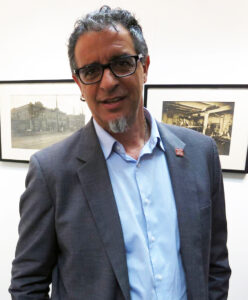 Joseph Sciorra is the Director for Academic and Cultural Programs at the John D. Calandra Italian American Institute, Queens College (City University of New York). He conceptualizes and implements scholarly research and public programs including symposiums, the Institute’s annual conference, the monthly “Writers Read” author series, the “Documented Italians” film and video series, and the “Philip V. Cannistraro Seminar Series in Italian American Studies,” as well as curates exhibitions.
Joseph Sciorra is the Director for Academic and Cultural Programs at the John D. Calandra Italian American Institute, Queens College (City University of New York). He conceptualizes and implements scholarly research and public programs including symposiums, the Institute’s annual conference, the monthly “Writers Read” author series, the “Documented Italians” film and video series, and the “Philip V. Cannistraro Seminar Series in Italian American Studies,” as well as curates exhibitions.
Sciorra received his Ph.D. from the Department of Folklore and Folklife at the University of Pennsylvania. As an ethnographer and cultural historian, he researches and publishes on vernacular culture, including religious practices, cultural landscapes, and popular music, among other topics.
He is the author of R.I.P.: Memorial Wall Art (Henry Holt & Co., 1994; Thames and Hudson, 2002) and Built with Faith: Italian American Imagination and Catholic Material Culture in New York City (University of Tennessee Press, 2015), which received the Italian American Studies Association 2016 book award.
He served as editor (2011-2016) of the Calandra Institute’s relaunched Italian American Review, a peer-reviewed social-science and cultural-studies journal. He is the editor of Italian Folk: Vernacular Culture in Italian-American Lives (Fordham University Press, 2011) and of Sacred Emblems, Community Signs: Historic Flags and Religious Banners from Italian Williamsburg, Brooklyn (John D. Calandra Italian American Institute, 2003).
He is the co-editor of Neapolitan Postcards: The Canzone Napoletana as Transnational Subject (Rowman & Littlefield, 2016), Reframing Italian America: Historical Photographs and Immigrant Representations (John D. Calandra Italian American Institute, 2015), Embroidered Stories: Interpreting Women’s Domestic Needlework from the Italian Diaspora (University of Mississippi Press, 2014), Graces Received: Painted and Metal Ex-Votos from Italy (John D. Calandra Italian American Institute, 2012), Mediated Ethnicity: New Italian-American Cinema (John D. Calandra Italian American Institute, 2010), and of poet Vincenzo Ancona’s Malidittu la lingua/Damned Language (Legas, 1990; 2010).
He is also the co-editor of a two-volume anthology, New Italian Migrations to the United States (University of Illinois Press, 2016), which explores Italian immigration to the United States from 1945 to the present via the lenses of history and politics, and culture and the arts. He most recently co-edited a special issue of the Italian American Review titled “Monuments, Memorials, and Italian Migrations. ”
Sciorra has conceptualized and curated several exhibitions, including “Evviva La Madonna Nera!: Italian-American Devotion to the Black Madonna” and “Sacred Emblems, Community Signs: Historic Flags and Religious Banners from Italian Williamsburg, Brooklyn.”
He has successfully nominated two examples of vernacular architecture—the Our Lady of Mt. Carmel Grotto on Staten Island and the Lisanti Family Chapel in the Bronx—to the New York State and National Registers of Historic Places. Sciorra assisted in the donations of artworks and artifacts to museums: Giovanni Inedlicato’s (nee Joe Milione) “Shoe Shine Stand” and Vincenzo Ancona’s “St. George and the Dragon” to the Fenimore Art Museum, Vincenzo Ancona’s “The Plowers,” “The Grape Harvest,” and “The Old Well” to the Museum of International Folk Art, and Rocco Costello’s zampogna (bagpipe) to the New-York Historical Society.
Sciorra is active as a cultural worker and public intellectual. Toward that end, he helped re-activate the annual September 8 celebration to the Black Madonna di Tindari in a gay bar, The Phoenix, in Manhattan’s Lower East Side. He also spearheaded a campaign to install a headstone on the unmarked grave of murdered labor activist Pietro “Pete” Panto (1910–1939).
Click here for CV.
